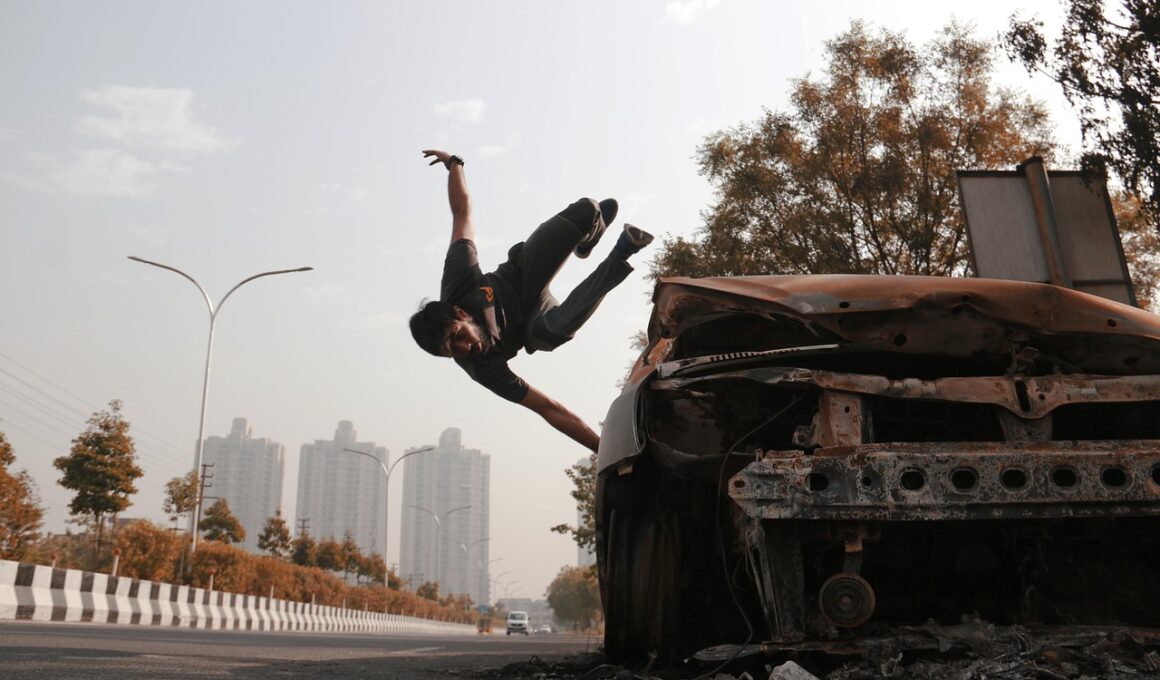The Globalization of Parkour: International Movements and Events
Parkour, originally developed in France in the late 20th century, has evolved into a global phenomenon. Its roots trace back to the French military obstacle course training known as “parcours du combattant.” From this foundation, David Belle and others shaped parkour into an urban art form focused on movement and efficiency. The rapid evolution of technology and the Internet has played a pivotal role in spreading the philosophy and practice of parkour worldwide. With social media platforms like YouTube and Instagram, practitioners can share their skills and experiences, reaching a wide audience. As communities identified with parkour became connected via online networks, gatherings, and meetups began to emerge. This newfound cohesion encouraged international competitions and events where athletes could display their talents and foster friendships across borders. Not only has parkour gained prominence in urban landscapes, but it has also diversified in styles and expressions, merging with dance, martial arts, and other disciplines. Consequently, parkour’s internationalization is more than a trend; it embodies a cultural exchange that transcends geographical barriers. This transformation now invites new generations to explore both the physical and philosophical aspects of movement.
The history of parkour showcases the emergence of various international movements that contribute to its distinct identity. In nations like the United States, UK, and Germany, local adaptations have birthed unique styles of parkour training. Athletes across these regions frequently incorporate elements from their respective cultures, enriching the practice with diverse techniques and philosophies. Additionally, more organized parkour scenes, driven by dedicated enthusiasts, have now paved the way for structured agencies, teams, and academies. Notably, established groups such as the World Parkour Federation and regional organizations have greatly influenced the sport’s global acceptance. Competitions, workshops, and meetups serve as platforms where practitioners share ideas, techniques, and community ethos. The rise of professional parkour athletes adds another dimension, as they now secure sponsorships and engage in brand partnerships. Not only does this professionalization increase the visibility of parkour, but it also enhances funding for local events. The international circuit of competitions inspired by the Parkour Generations and Red Bull Art of Motion further unites global practitioners under a shared love for the sport. With each event, the bond between athletes deepens, enriching the tapestry of parkour’s cultural history.
The Role of Social Media in Spreading Parkour Culture
Social media has been instrumental in the globalization of parkour, allowing practitioners to connect and share their journeys worldwide. Platforms like YouTube and Instagram have given rise to countless parkour enthusiasts showcasing their skills, tricks, and personal stories. Influencers have emerged, often driving trends and inspiring fans across the globe. Videos featuring urban landscapes and iconic locations have sparked interest, encouraging local communities to form in places previously unaware of parkour. Furthermore, tutorials and training tips shared online have democratized knowledge, enabling beginners from various backgrounds to learn the discipline. Challenges and trends on social media motivate practitioners to push their limits, explore new techniques, and connect with others. These influences continuously shape the parkour landscape as practitioners adapt global trends to fit their local contexts. Events like the #ParkourChallenge gain traction, drawing participants from multiple countries who share their interpretations online. This unity among practitioners fosters a sense of belonging and invigorates the global community. Ultimately, social media is not just a marketing tool, but a critical component in enhancing the visibility and passion for parkour across borders.
International events and competitions embody the spirit and evolution of parkour, attracting a diverse array of participants. These competitions serve as a stage where athletes demonstrate their skills while creating an atmosphere of camaraderie and inspiration. For instance, events like the World Parkour Championships or the Red Bull Art of Motion draw in top talent from around the world, celebrating not just athletic prowess but also creativity in movement. Organizing such events involves significant effort, with local teams coordinating logistics, securing sponsorships, and fostering community participation. Essential to this process is establishing partnerships with local businesses and governments to enhance recognition of parkour’s cultural impact. Local competitions often feature grassroots initiatives that encourage newcomers to participate and gain exposure to the parkour community. As a result, international gatherings also energize local scenes, inspiring aspiring athletes to hone their skills and push limits. Each year, these events help bridge gaps between cultures, facilitating a shared passion for movement. The celebratory atmosphere surrounding competitions cultivates friendships and networks that extend beyond the events, ultimately reinforcing the global parkour family.
Parkour in Popular Culture and Media
The presence of parkour in popular culture and media has dramatically influenced its growth and acceptance. Films like “District 13” showcased the exhilarating aesthetics of parkour stunts, captivating audiences worldwide. Similarly, video games, television shows, and commercials that incorporate parkour elements have contributed to creating a mainstream image of the discipline. By integrating parkour with cinematic storytelling, directors highlight not just athletic ability, but also the creativity and artistry behind movement. Beyond the screen, documentaries exploring the lives of prominent figures in the parkour community further humanize the sport. These portrayals invite viewers into the world of parkour, revealing the dedication and commitment required to master it. The portrayal of diverse athletes challenges stereotypes and invites a more inclusive perspective within the community. As parkour becomes more visible in popular culture, it attracts a broader audience, pushing the sport closer to professional status. The media thrives on showcasing extraordinary physical feats, yet beneath this veneer lies a community grounded in philosophy, shared experiences, and self-expression, connecting people globally through a love of movement.
Continuing the narrative of parkour’s globalization, cross-cultural exchanges play an important role in shaping the future of the discipline. With growing acceptance, international collaborations between different parkour communities have emerged, fostering mutual respect and understanding. These interactions promote learning and sharing varied training techniques and philosophies. Workshops and exchange programs allow practitioners to travel and train in other countries, creating bonds that transcend language barriers. Such experiences promote the essence of parkour, which emphasizes freedom, creativity, and personal growth. Collaborative events organized between countries further encourage athletes to explore diverse settings and environments that challenge their skills. As cultural boundaries blur, the understanding of parkour becomes richer and more nuanced. This international dialogue also cultivates new ideas, pushing the discipline toward innovative practices. Cross-cultural influences can lead to a reevaluation of traditional movements, allowing for a fusion that celebrates diversity while maintaining fundamental principles. As these exchanges continue, the parkour community grows tighter, with practitioners inspired by each other’s journeys, techniques, and philosophies. In this manner, the spirit of parkour thrives, reflecting the universality of human movement and connection.
The Future of Parkour: Challenges and Opportunities
The future of parkour remains uncertain yet filled with potential, as the discipline faces challenges while also embracing new opportunities. As parkour gains mainstream attention, there are ongoing concerns regarding commercialization versus authenticity. Striking a balance between professionalization and community essence is critical, ensuring that the roots are not lost amidst growing sponsorship interests. Educating newcomers about the core philosophy of parkour—self-improvement, creativity, and respect—is vital in maintaining its integrity. Conversely, with the expansion of parkour into fields like education and rehabilitation, innovative opportunities arise for practitioners. Collaborations with schools and organizations aim to promote physical literacy through parkour, illustrating its benefits for youth engagement and overall health. This diversification enhances the sport’s reach, encouraging non-traditional audiences to participate. As parkour evolves, the setting of wellness and mental health initiatives arises, emphasizing the discipline’s holistic benefits. The passion and resilience of the community are essential in navigating the future ahead. Through collaboration and mutual support, the parkour community can thrive, preserving its core principles while embracing new avenues for growth.
Welcome to the Future of Parkour
As we move forward, the growth of parkour presents exciting opportunities alongside inherent challenges. With the ongoing expansion of the parkour community, the focus on maintaining authenticity and inclusivity remains paramount. Challenges stemming from commercialization and the desire for professionalization will continuously need to be addressed to preserve the sport’s core values. Educating practitioners about the philosophy behind parkour is crucial in ensuring that the essence remains intact, regardless of evolving trends. Meanwhile, opportunities are emerging in education, therapy, and personal development, expanding the horizons for practitioners. Increasing collaborations with educational institutions showcase parkour as a tool for physical fitness and mental well-being. Initiatives aimed at young people and communities can effectively demonstrate the numerous benefits of parkour, such as improving physical health, instilling discipline, and fostering social connections. There is a chance to incorporate parkour in youth programs, showcasing its versatility. Moreover, international partnerships can nurture cross-cultural exchanges, enriching the experience and knowledge of the global parkour family. As parkour continues to evolve, the future may hold greater recognition and integration into various aspects of culture, inviting growth while challenging the sport’s identity.


